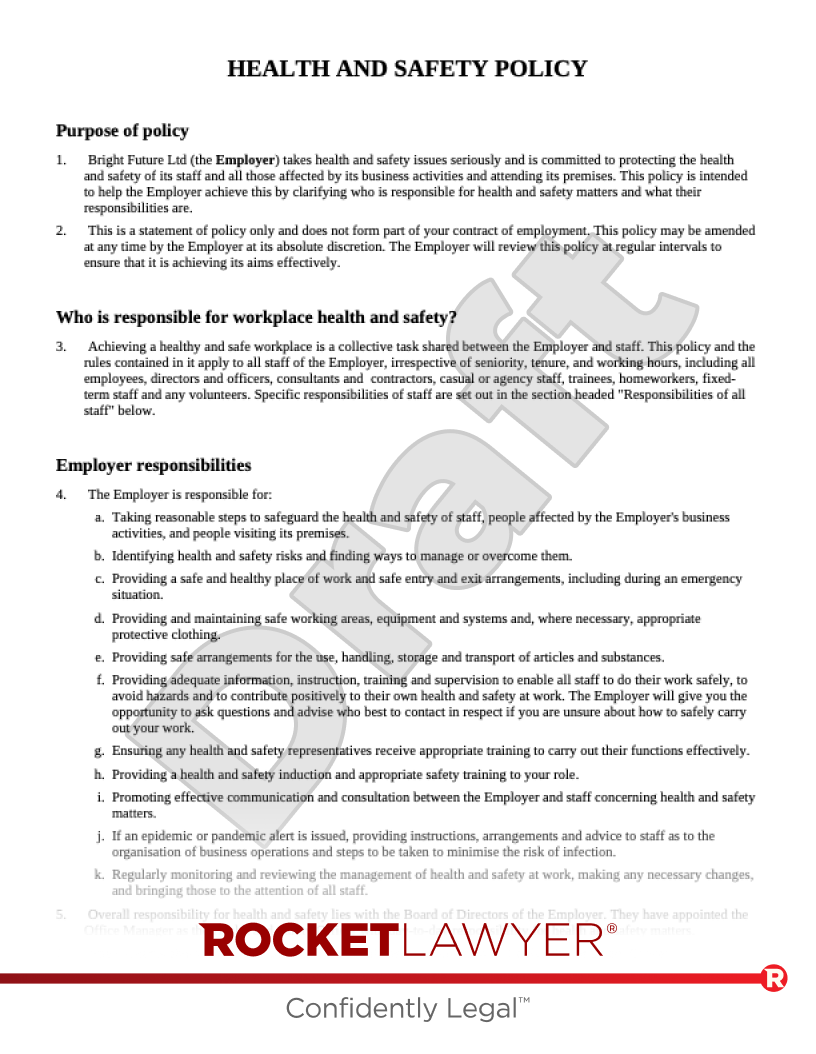Explicit and implicit legal requirements
There are three key pieces of legislation governing the provision of facilities in the workplace. These are The Workplace (Health, Safety, and Welfare) Regulations 1992, the Health and Safety at Work etc. Act 1974 and The Management of Health and Safety at Work Regulations 1999. The Equality Act 2010 can also play a role.
The first of these sets out explicit requirements for welfare facilities that employers must provide. This should be done as far as is ‘reasonably practicable’, which means that it should be done unless it is demonstrably difficult due to time, trouble, and cost. If the inconvenience caused to the employer is minimal, then it is likely to be thought of as being reasonable to make the changes.
The legislation creates implicit, often context-dependent, requirements. Employers must make sure they provide their employees with everything they are explicitly or effectively required to provide. For completeness, these requirements extend to remote-/hybrid- and mobile workers.
Drinking water
Legally, it’s fine for employers to require their employees to use tap water, as long as it’s safe to drink (which it should be in the UK). If tap water is unavailable, employers must provide an alternative such as bottled water.
Employers must provide drinking receptacles of some form (eg glasses). They must also ensure that employees can access water as necessary.
What this means in practice is very much context-dependent. For example, it might be considered perfectly fine to have employees in an air-conditioned office walk along a corridor to a single water cooler. By contrast, it might be considered completely unacceptable to expect the same from manual workers in a hot environment.
Break facilities
An employer must provide a place to heat food and a place to sit down and eat it. Employees must also be able to access washing facilities nearby. In general, however, this requirement can be satisfied by the provision of toilets (which are mandatory).
There is no requirement to provide employees with a fridge in which to store food. There is, however, a requirement for employers to provide nursing mothers with a place to store expressed breast milk if this is requested.
Effectively, employers are also required to provide a fridge for any employee who needs it for medical purposes. This would typically be to store medication. Failure to do so would probably be a breach of health and safety obligations and is likely to be viewed as discriminatory behaviour.
Realistically, it is strongly advisable for employers to provide the best break facilities they can manage. The legal reason for this is that the law now clearly recognises that the principle of health and safety applies to employees’ mental health as well as their physical health. Providing high-quality break facilities can help to foster mental wellness at work.
For more information on rest breaks, read Pay and benefits.
Toilets and washing facilities
Employers must provide sufficient toilet facilities for their staff. These include both the toilets themselves and the relevant washing facilities (eg sinks). All toilet facilities must be adequately lit, although this applies throughout the entire workplace.
The number of toilets provided must be proportionate to the number of employees. There are legal guidelines on this. As always, however, these are minimum standards, not targets.
There should be separate toilets for males and females if possible. If this is not possible or if employers wish to have gender-neutral toilets, toilets should be in separate, lockable rooms.
For mixed-use or women-only toilets, employers need to have:
-
1 toilet if they have less than 5 employees
-
2 toilets if they have between 6 and 25 employees
-
3 toilets if they have between 26 and 50 employees
-
4 toilets if they have between 51 and 75 employees
-
5 toilets if they have between 76 and 100 employees
It should also be noted that when an employer provides toilets for women, they should make sure that users have a hygienic way for them to dispose of sanitary materials.
For toilets used by men only, employers need to have:
-
1 toilet and 1 urinal if they have between 1 and 15 employees
-
2 toilets and 1 urinal if they have between 16 and 30 employees
-
2 toilets and 2 urinals if they have between 31 and 45 employees
-
3 toilets and 2 urinals if they have between 46 and 60 employees
-
3 toilets and 3 urinals if they have between 61 and 75 employees
-
4 toilets and 3 urinals if they have between 76 and 90 employees
-
4 toilets and 4 urinals if they have between 91 and 100 employees
Washing facilities
When providing toilet facilities, employers also have to provide sinks for employees to wash their hands plus the associated facilities (eg soap and dryers). Sinks must have hot and cold water.
In the construction industry, sinks need to be large enough for employees to fit their arms into in order to wash them thoroughly and to any skin conditions from forming.
When employees are working on temporary sites, it can be more difficult to provide the right ratios and facilities, and public toilets should only be used as a last resort. However, portable toilets can provide the perfect solution. They usually come with sinks, washing facilities and sanitary bins to ensure that employers are meeting their welfare requirements with a minimum of hassle.
Changing and showering facilities
If employees need to get changed at work (eg in and out of uniforms), then employers must provide suitable facilities for them to do so.
Men and women must have separate and private changing rooms. Employers may also need to provide space for employees to dry wet clothing and/or store dirty clothing.
If an employee’s work involves them getting dirty, sweaty, or smelly, then employers are likely to need to provide facilities for them to shower. Showers should supply both hot and cold water, and soap, towels, and adequate ventilation should also be supplied. Men and women should be provided with separate wash facilities unless there is a secure lock on the facility and it is only intended for one person’s use at a time.
Personal protective equipment
Personal protective equipment (PPE) must be provided and well looked after. It needs to be stored in a suitable location and there must be enough to go around for those that need it.
Employers should regularly review their PPE to make sure that it is in good order and that it is being used correctly. This will give them the chance to replace anything that has seen better days and to review training if it is not being used in the way that it was intended.
Employers may also want to consider installing signs as a reminder to wear PPE.
For more information, read Do employers have to provide workwear?
First aid, rest and assistive facilities
Employers must have first-aid facilities on-site. Again, the extent of first-aid provision depends on the number of employees a business has. Also, again, this is a minimum standard, not a target. For more information, see the Health and Safety Executive (HSE) guidance on first aid in the workplace.
Technically, employers are only legally required to provide rest facilities if they are employing pregnant or nursing mothers. In practice, however, it generally makes sense to provide these facilities to other employees too.
If an employee has a disability, then an employer is required to make ‘reasonable adaptations’ (ie reasonable adjustments) to assist them in performing their duties. What this means in practice is 100% context-dependent. It could mean anything from text-to-speech converters to installing wheelchair-friendly doors.
For more information, read Health and safety.
Workplace functionality
Employers must ensure that they provide whatever facilities, amenities and items of equipment are necessary to allow a workplace to function healthily and safely. This can cover anything from light, to personal space for each employee, to ergonomic office equipment. This last option can straddle the line between amenity and essential.
For example, employees may prefer to swap out traditional office chairs in favour of newer alternatives such as adjustable-height stools or kneeling stools. They may also request adjustable-height desks. As a rule of thumb, it’s best to assess each application on its own merits and support them whenever possible.
For more information, read Health and safety.
Mental wellness
This is possibly the biggest challenge modern employers have to face. Part of the reason why it’s such a challenge is that there is no ‘magic bullet’ to deal with it. Promoting mental wellness at work typically requires a multi-pronged approach based on a sincere commitment from management. With that said, facilities and amenities can certainly play a role.
Just about everyone is likely to need some mental and/or physical breathing space at their work from time to time. In some cases, that will mean time out in a private place. In others, it will mean time out in a social environment. Recognising this can go a long way towards promoting mental wellness at work.
Employees who feel mentally supported and appreciated are likely to be happier. They are, therefore, likely to stay longer and perform better. They are highly unlikely to end up bringing personal injury claims for mental health issues caused by (or at least exacerbated by) their work and/or employer.
For more information, read How to support mental health and wellbeing in the workplace.
Maintaining workplace facilities
Providing welfare facilities is one thing, but employers also need to make sure that these are well-maintained. They should be clean and hygienic as well as in good working order. This will need to be regularly reviewed and employers will need to revisit the numbers that they need as more staff are recruited into the business.
Welfare facilities are not just a legal requirement but also something that employers should want to offer as a good employer. Making life comfortable for employees through reasonable standards is the minimum that anyone should expect when coming to work. An employee who feels that they are well looked after and cared for is more likely to give their all for the business and stay a loyal member of staff for a long time.
Employers should ensure that they have in place adequate policies to ensure the health and safety of their workforce. What specific policies may be necessary depends on the specifics of the situation. However, any business with 5 or more employees must have a written Health and safety policy in place.
For more information on any other policies you may wish to create, see the HR policies checklist. If you have any questions or concerns or don’t know where to start, Ask a lawyer.





